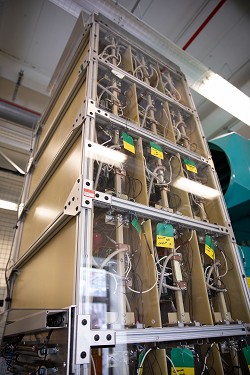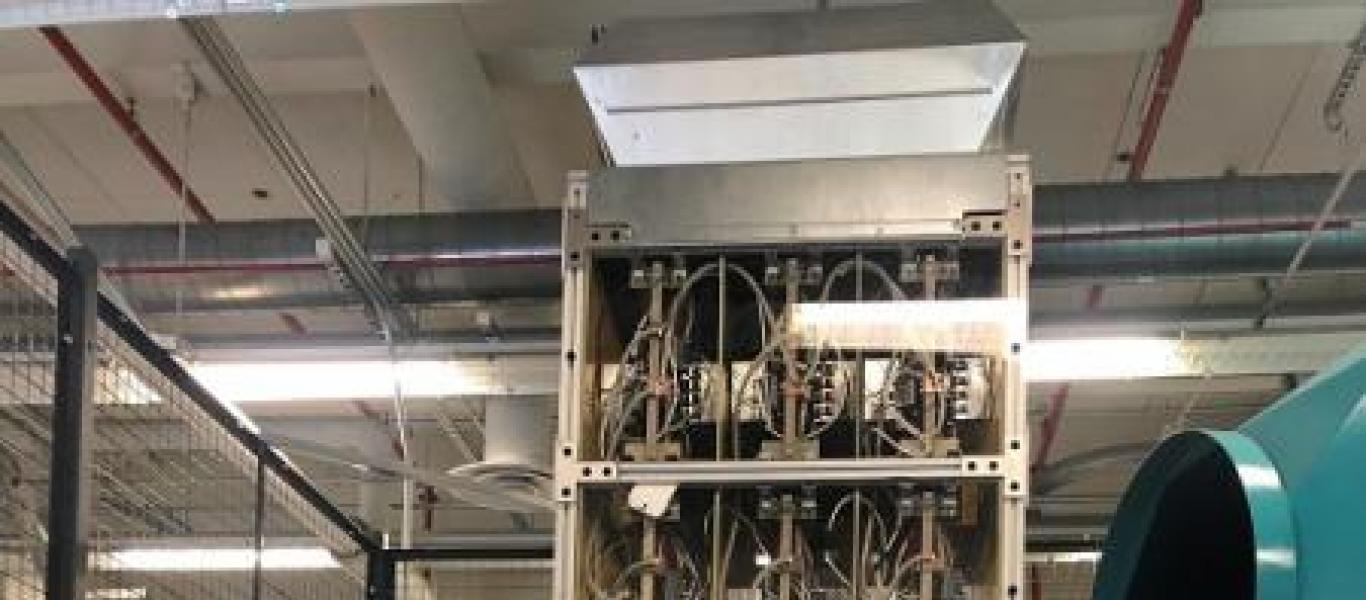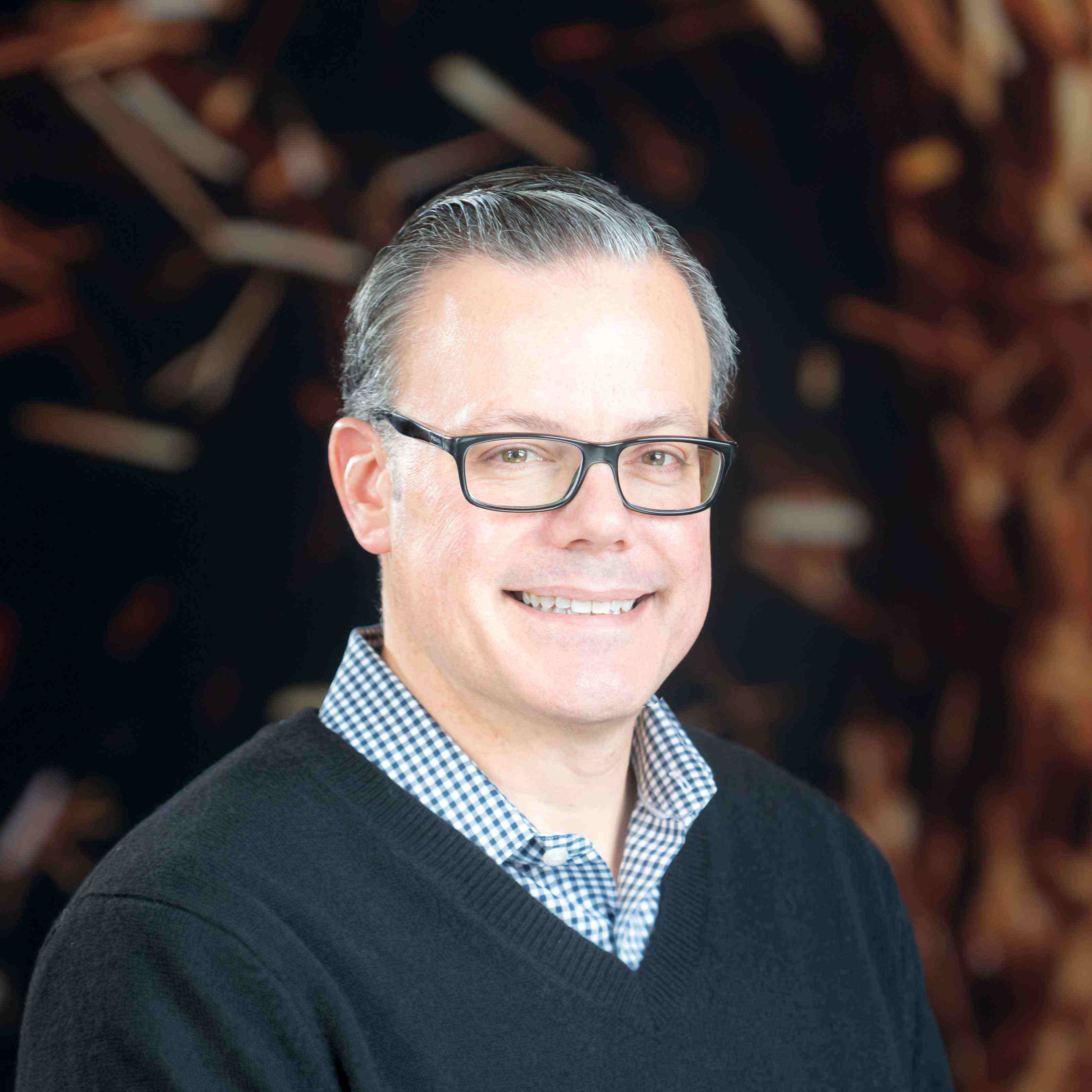- Caps successful completion of five-year project through the U.S. Department of Energy Advanced Manufacturing Office’s (AMO) Next Generation Electric Machines program
- The GE Research Converter team created a virtual 3.5 MW wind turbine in the lab to demonstrate its “Tower of Power” at full scale
- New modular architecture will enable improved resiliency and reliability by isolating any issues to individual blocks without compromising the overall converter system
- New converter furthers next generation developments for GE’s Wind business, while creating more potential commercialization opportunities in the broader power conversion sector
NISKAYUNA, NY – March 12, 2020 – A team of engineers in the Electrical Systems group at GE Research have achieved one of the world’s firsts in the power conversion sector, demonstrating a MW-scale modular, multi-level wind power converter in its lab in Upstate New York. The demonstration successfully culminates the key objective a five-year project through the U.S. Department of Energy (DOE) Advanced Manufacturing Office’s (AMO) Next Generation Electric Machines program.
While the principal objective of the program was to demonstrate the wind power converter, another positive outcome of the project was the development and demonstration of an early power conversion system for hybrid electric flight. Hybrid electric flight is another key focus area for GE Research and for the DOE’s AMO.
To pull off the wind converter demonstration, GE engineers turned one of their labs on campus into a virtual 3.5 MW wind turbine outfitted with an actual wind generator and gearbox from GE’s Renewable Energy business. GE scientists then developed, built and integrated its modular, multi-level “Tower of Power,” as it was coined by the team, into this virtual environment. The setup allowed the converter to be tested under real conditions as if a 300+ foot high wind turbine was standing tall and spinning in the middle of GE’s Research campus.
“The ability to build and test this type of breakthrough modular power conversion architecture at scale is a testament to the power of government partnership and industrial research in translating new technology into real solutions that transform the future of energy,” said Nathaniel Hawes, Principal Engineer in the Electrical Systems group at GE Research and project leader. “Through our work on this project, we have advanced the ball on future wind converter technology and created more potential opportunities to deploy this technology in other parts of the power conversion sector.”
Hawes noted that his team is now exploring potential commercial opportunities with GE’s Power Conversion business, which sells power conversion solutions into specialized sectors such as energy, marine and other industries.
Hawes said, “The operational flexibility our modular system provides is particularly attractive for industry applications that place a high premium on resiliency and reliability.” Today’s power conversion systems typically can operate for long periods of time, but when a single circuit board goes down, the whole system is temporarily disabled. And with obsolescence often encountered around parts to repair it, these repairs are often delayed. With a modular architecture, the dynamic is totally different.

Caption: Pictured is GE's new modular, multi-level wind power converter, known as the "Tower of Power," which GE researchers demonstrated at full scale in its Niskayuna lab facilities with the equivalent power of a 3.5 MW wind turbine.
GE’s Power Conversion "Tower of Power"
GE’s new modular, multi-level power conversion architecture, Hawes says, was built like toy blocks, or bricks.
“As opposed to one big power conversion box, we create one or a few standard building block(s) and then build and “stack up” multiple building blocks to make up a variety of power conversion systems that collectively control power output,” Hawes said. “If one building block goes down, I don’t need to worry because the other building blocks or boxes will continue to function just fine and I can even design my systems with extra boxes or ‘bricks,’ as redundancy, which I can activate to supplement those that are offline.”
Hawes noted that the repairs to the smaller boxes versus one big system can actually be made faster too, in addition to the reduced spare parts inventory and product life cycle cost.
“We’re at the dawn of a new revolution in power conversion, with the successful demonstration of a modular, multi-level power conversion system. We’re excited to take the next steps of exploring new commercial opportunities with GE’s Power Conversion business, while continuing the journey in broader power conversion sector.”
About GE Research
GE Research is GE’s innovation powerhouse where research meets reality. We are a world-class team of scientific, engineering and marketing minds working at the intersection of physics and markets, physical and digital technologies, and across a broad set of industries to deliver world-changing innovations and capabilities for our customers. To learn more, visit our website at https://www.ge.com/research/.
"This material is based upon work supported by the Department of Energy Office of Energy Efficiency and Renewable Energy (EERE), under Award Number DE-EE0007252."
Disclaimer
"This Report was prepared as an account of work sponsored by an agency of the United States Government. Neither the United States Government nor any agency thereof, nor any of their employees, makes any warranty, express or implied, or assumes any legal liability or responsibility for the accuracy, completeness or usefulness of any information, apparatus, product, or process disclosed, or represents that its used would not infringe privately owned rights. Reference herein to any specific commercial product, process , or service by trade name, trademark, manufacturer, or otherwise does not necessarily constitute or imply its endorsement, recommendation, or favoring by the United States Government or any agency thereof. The views and opinions of authors expressed herein do not necessarily state or reflect those of the United States Government or any agency thereof."
We're here to solve your toughest problems.






